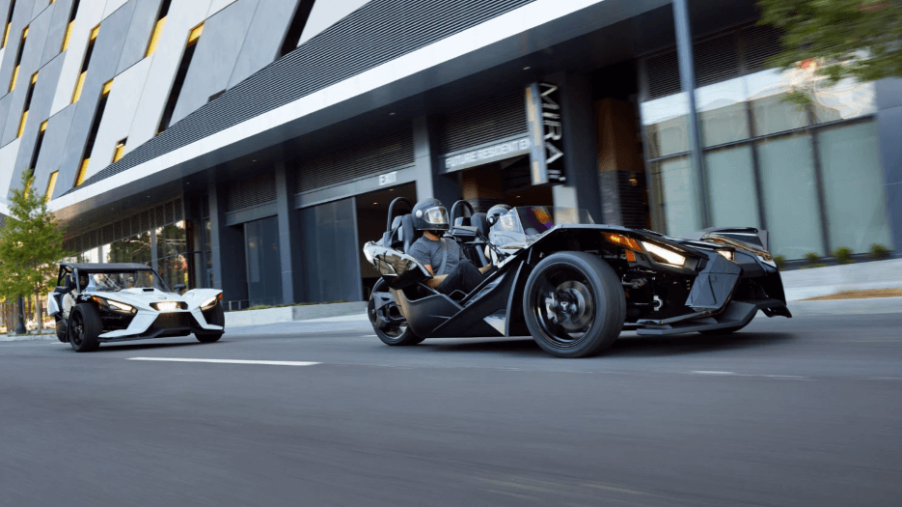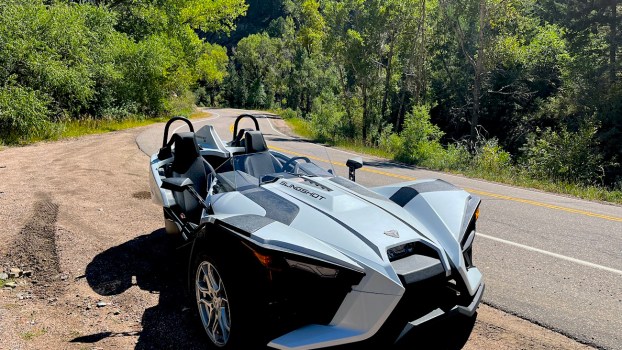
You Don’t Need to Understand Why the Polaris Slingshot Exists to Enjoy It
The Polaris Slingshot has three wheels, an open cockpit, bodywork that is eye-catching though extremely limited in its coverage, and a sprinkling of modern automotive conveniences while requiring its drivers to wear a full-face helmet. So then, the Slingshot is an amalgamation of a motorcycle and a car, blending the line between the pros and cons of each segment — a product seemingly no one asked for.
So, why does the Polaris Slingshot exist? It’s a question that’s not quite easy to answer, but after two weeks behind the wheel, I have a much better idea.
The Polaris Slingshot — for people who have no interest in motorcycles
There are a few guarantees that come with traveling in metro Atlanta — heavy traffic is omnipresent, every major highway has a mixture of those traveling at the speed of smell mixed in with those who can somehow manage to get a Nissan Versa up to 183 mph, and every motorcycle rider from the area has a plethora of near-death, two-wheel experiences. Because of the latter, I have never found any appeal in owning a motorcycle. I feel signing on the dotted line to purchase one is no different than putting out a “hit” contract on myself.
I fully understand the appeal of open-air, two-wheel cruising; I just don’t want any part of it.
But throw in a third wheel, a frame, a traditional seat, and other car conveniences mixed in with the positive aspects of motorcycle cruising, and I’m interested. And that is the extremely niche segment in which the Polaris Slingshot resides.
Like a motorcycle, you need to throw your leg over its frame to get in or out. You’ll likely do so while wearing a full-fact, DOT-approved helmet, as they’re required for any passengers in the Slingshot in most areas (Georgia included). Set off, and you’ll hear its transmission, either an automatic or five-speed manual, whine. Engine noise is pervasive. Sure, there’s a windscreen, but it ends at about eye level. Of course, you are also completely exposed to the elements.
Then again, you’re seated on a traditional car seat, even if it’s covered in weather-resistant upholstery. There’s push-button start. There are traditional controls on the steering wheel and the dash underneath the 7-inch display. There are storage cubbies behind each seat and cupholders in the center console. You and your passenger are in close quarters but don’t have to cuddle. And there’s no risk of, well, falling over.
So, how does the car/cycle amalgamation translate to the road?
The Slingshot’s driving dynamics
The Polaris Slingshot is powered by a Prostar 2.0-liter four-cylinder engine delivering 178 horsepower at an ear-splitting 8,500 RPM and 120 lb-ft of torque in its base and SL guise (which I tested). Upper models increase power output to 203 ponies and 144 lb-ft of twist. The 178-hp version is still plenty of get-up-and-go as the Slingshot weighs in at just 1,652 pounds. If you need motivation to hit the gym some more, just consider how much your own weight is impacting this featherweight’s power-to-weight ratio — I certainly did.
While the Slingshot can be had with an automatic transmission, I’m convinced the five-speed manual should be the only option — why buy an automotive toy if you’re going to let it do all the work? The engagement the stick provides would be sorely missed, but more than that, the manual is satisfying to drive. The clutch is extremely easy to modulate, and each shift throw is met with a satisfying clunk into the next gear.
The Slingshot feels surprisingly planted, given its three-wheel setup, but that’s not to say it can’t carve corners like a well-honed chef’s knife. The 255-mm width rear wheel in the SL model could be considered a member of the “lifestyle” considering how much it likes to swing, at least under hard acceleration. However, I didn’t encounter a singular-rear-wheel drift that wasn’t easily controlled with some throttle manipulation. The Slingshot may not ride as if it were on rails, but thrashing around curvy tarmac will undoubtedly put a smile on your face.
Braking will not.
Upper models can be had with four-piston Brembo brakes, but the SL settles for aluminum one-piston units. I felt the wind resistance of my helmet was doing about as much to bring the Slingshot to a stop as the actual brakes. Therefore, engine braking is another benefit of springing for the manual.
The SL’s steering rack has an appropriate heft and provides a good amount of feedback. Then again, being able to see exactly where the front wheels are located relative to the apex helps.
The Polaris Slingshot is a truly unique experience
Just about all the Polaris Slingshot’s driving characteristics can be experienced in other models of various types, but none can deliver the overall novelty of piloting the Slingshot. For better or worse.
The act of passing a truck feels wholly conventional — use the turn signal stalk, merge into the passing lane, and give the right pedal a bit of an extra push. Yet, you’ll be checking your blind spots through a visor, and wind buffeting will throw your head around a bit while completing the pass.
People will talk to you about the Slingshot as you park, and you’ll be on the receiving end of gawks each time you pull up to a red light. This car is an extrovert’s dream and an introvert’s nightmare.
You’ll get a whiff of scents you would have otherwise missed in a traditional cabin — for the better, like the pork-scented smoke of a BBQ joint you can’t even see yet, or the worse, like passing by a water treatment facility and having its stench seemingly trapped inside your helmet.
Additionally, you’ll be exposed to all the elements. On a cool, sunny day, the Slingshot is perhaps the ultimate automotive way to enjoy the weather. Then again, you’ll likely end up with a nasty sunburn if you don’t prepare accordingly, and any turn of the weather will make you regret taking it out in the first place.
If Polaris intended the Slingshot to be a blend of the best aspects of driving a car and piloting a motorcycle, job well done. But there cannot be such an unconventional mixture, like Kahlua and lime juice, without some downsides.
I don’t know why the Slingshot exists, but it’s easy to appreciate
No matter how you slice it, the PolarisSlingshot is unique. That’s perhaps its best attribute. Every drive is entertaining, and that’s not something you can say of many vehicles you can put in your garage for under $30,000.
If I may age myself, the day I received my license, I happily volunteered to run to Blockbuster to return a movie my mother rented — it was simply an excuse to get behind the wheel. I felt similar pangs with the Slingshot in my driveway. Are we out of milk? No problem, I’d tell my wife while grabbing the Slingshot’s fob. My favorite pen is out of ink? I’m going to run to the store and grab another. It’s a nice day outside? How about we go to the park…taking the long way to get there.
Despite its limited pragmaticism, the Slingshot became my go-to errand runner mobile for two weeks. Going to get a sack of oranges from the grocery store because my daughter somehow ate her weight in the things over the course of five days wasn’t necessarily a chore because the time spent behind the wheel of the Slingshot was always amusing.
Would I dish out $27,499 for the midrange SL model I tested or even save some dough with the base S model that commands $21,499? Well, no. I’m an automotive journalist (Motto: We test cars we could never afford with our salaries), and there are far more pragmatic automotive toys I could have for the money.
However, for those who want the better aspects of piloting a motorcycle with the ease of piloting a car, the Slingshot is certainly endearing. I still don’t know why it exists, but I’m glad it does.




